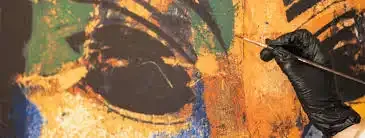Image Colorization
- #Python
# Colorização de Imagem com OpenCV:
Este código tem tudo a ver com a colorização de uma imagem em tons de cinza usando um modelo de rede neural profunda pré-treinado. Vamos detalhar passo a passo:
1. **Importação de bibliotecas:**
- «numpy» para operações numéricas.
- 'matplotlib.pyplot' para plotagem de imagens.
- 'cv2' (OpenCV) para tarefas de visão computacional.
2. **Carregando a imagem de teste:**
- Lê uma imagem em tons de cinza especificada pelo caminho do arquivo usando OpenCV.
- Verifica se a imagem foi carregada com sucesso.
3. **Exibindo Imagem Original:**
- Se a imagem for carregada com sucesso, ela é exibida usando Matplotlib com um colormap cinza e interpolação bicúbica.
4. **Definindo caminhos para modelo e dados:**
- Especifica caminhos para o modelo Caffe, arquivo prototxt e arquivo numpy.
5. **Carregando o modelo Caffe:**
- Lê o modelo Caffe e configura algumas camadas para colorização.
6. **Pré-processamento de imagem:**
- Lê a imagem de teste novamente e converte-a de BGR para escala de cinza e, em seguida, para o formato RGB usando OpenCV.
- Normaliza os valores da imagem.
- Converte a imagem RGB em formato LAB.
7. **Extraindo o canal L:**
- Redimensiona a imagem LAB.
- Extrai o canal L (luminância) e subtrai 50 dos seus valores.
8. **Prevendo canais a e b:**
- Define o canal L como entrada para a rede pré-treinada.
- Prevê os canais 'a' e 'b' para colorização.
9. **Combinação de canais:**
- Combina o canal L original com os canais 'a' e 'b' previstos para criar uma imagem LAB colorida.
10. **Convertendo LAB para RGB:**
- Converte a imagem LAB de volta para o formato RGB.
11. **Ajustando os valores de pixel:**
- Clipa e dimensiona valores de pixel para o intervalo [0, 255].
12. **Exibindo imagem colorida:**
- Exibe a imagem colorida usando Matplotlib.
13. **Salvando a imagem colorida:**
- Converte a imagem RGB para o formato BGR (convenção OpenCV) e salva-a no caminho de saída especificado.
Em resumo, o código pega uma imagem em tons de cinza, processa-a através de uma rede neural pré-treinada para prever canais de cores e, em seguida, exibe e salva a imagem colorida resultante.
# Importing libraries
import numpy as np
import matplotlib.pyplot as plt
import cv2
# Name of testing image
image_path = 'whale.jpg'
# Load the image
test_image = cv2.imread(image_path, cv2.IMREAD_GRAYSCALE)
# Check if the image is loaded successfully
if test_image is not None:
# Display the image with gray colormap and bicubic interpolation
plt.imshow(test_image, cmap='gray', interpolation='bicubic')
plt.axis('off')
plt.show()
else:
print("Error: Unable to load the image.")
# Path of our caffemodel, prototxt, and numpy files
prototxt = "colorization_deploy_v2.prototxt"
caffe_model = "colorization_release_v2.caffemodel"
pts_npy = "pts_in_hull.npy"
test_image = "test_samples/" + image_path
# Loading our model
net = cv2.dnn.readNetFromCaffe(prototxt, caffe_model)
pts = np.load(pts_npy)
layer1 = net.getLayerId("class8_ab")
print(layer1)
layer2 = net.getLayerId("conv8_313_rh")
print(layer2)
pts = pts.transpose().reshape(2, 313, 1, 1)
net.getLayer(layer1).blobs = [pts.astype("float32")]
net.getLayer(layer2).blobs = [np.full([1, 313], 2.606, dtype="float32")]
# Converting the image into RGB and plotting it
# Read image from the path
test_image = cv2.imread(test_image)
# Convert image into gray scale
test_image = cv2.cvtColor(test_image, cv2.COLOR_BGR2GRAY)
# Convert image from gray scale to RGB format
test_image = cv2.cvtColor(test_image, cv2.COLOR_GRAY2RGB)
# Check image using matplotlib
plt.imshow(test_image)
plt.axis('off')
plt.show()
# Converting the RGB image into LAB format
# Normalizing the image
normalized = test_image.astype("float32") / 255.0
# Converting the image into LAB
lab_image = cv2.cvtColor(normalized, cv2.COLOR_RGB2LAB)
# Resizing the image
resized = cv2.resize(lab_image, (224, 224), interpolation=cv2.INTER_CUBIC)
# Extracting the value of L for LAB image
L = cv2.split(resized)[0]
L -= 50 # OR we can write L = L - 50
# Predicting a and b values
# Setting input
net.setInput(cv2.dnn.blobFromImage(L))
# Finding the values of 'a' and 'b'
ab = net.forward()[0, :, :, :].transpose((1, 2, 0))
# Resizing
ab = cv2.resize(ab, (test_image.shape[1], test_image.shape[0]))
# Combining L, a, and b channels
L = cv2.split(lab_image)[0]
# Combining L,a,b
LAB_colored = np.concatenate((L[:, :, np.newaxis], ab), axis=2)
# Checking the LAB image
plt.imshow(LAB_colored)
plt.title('LAB image')
plt.axis('off')
plt.show()
## Converting LAB image to RGB
RGB_colored = cv2.cvtColor(LAB_colored, cv2.COLOR_LAB2RGB)
# Limits the values in array
RGB_colored = np.clip(RGB_colored, 0, 1)
# Changing the pixel intensity back to [0,255], as we did scaling during pre-processing and converted the pixel intensity to [0,1]
RGB_colored = (255 * RGB_colored).astype("uint8")
# Checking the image
plt.imshow(RGB_colored)
plt.title('Colored Image')
plt.axis('off')
plt.show()
# Saving the colored image
# Converting RGB to BGR
RGB_BGR = cv2.cvtColor(RGB_colored, cv2.COLOR_RGB2BGR)
# Saving the image in the desired path
outImage = 'outImg.jpeg'
cv2.imwrite(outImage, RGB_BGR)
https://github.com/demoner21/Pixel_and_Poetry
https://medium.com/@Pixel_and_Poetry






